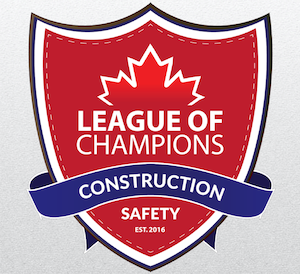League of Champions webinar discusses COVID safety on construction sites
Now that the Government of Ontario has lifted the suspension on construction work across all sectors of the industry, what can contractors do to ensure their sites remain safe—and open—during and after the COVID-19 pandemic?
 That was one of the central discussion points during a webinar hosted by the League of Champions on May 14. Over the course of the session, industry leaders discussed those approaches contractors can take to keep their sites safe and instil a strong sense of confidence among workers that every necessary step is being taken to protect them from the spread of the novel coronavirus.
That was one of the central discussion points during a webinar hosted by the League of Champions on May 14. Over the course of the session, industry leaders discussed those approaches contractors can take to keep their sites safe and instil a strong sense of confidence among workers that every necessary step is being taken to protect them from the spread of the novel coronavirus.
Among those speaking was Chief Prevention Officer Ron Kelusky. He pointed to the feedback provided to him by Premier Doug Ford about the excellent work the construction sector is doing to respond to safe-working guidelines during the pandemic.
“COVID-19 has been a game-changer for construction in a positive way,” he said. “The industry can be proud of the way it has responded to the outbreak, and the fact that there are no reported COVID cases on any sites.”
Going forward, Kelusky said the key for the industry will be to reinforce the hierarchy of controls in place to prevent the spread of the virus. That begins with ensuring workers on site are properly screened for exposure to the virus, enforcing physical distancing to the fullest extent possible, and providing personal protective equipment and taking special measures to protect workers when they must be within two metres of each other.
Craig Lesurf, president of the Gillam Group, spoke about the particular safety operations his firm has put in place during the pandemic. Like Kelusky, he stressed the significance of adopting a hierarchy of controls to stop the spread of the virus onto a construction site. For Gillam, that process begins with eliminating exposure to the virus, or screening everyone who comes on to the site for symptoms or exposure. The next step is controlling the hazard, which translates to isolating people from the hazard—either via quarantine at home or by cleaning the site if someone presents symptoms on the site. He then pointed to the need to change the way people work, such as by putting a sharper focus on hygiene at the site, and finally by giving workers access to the personal protective equipment—face shields, masks and gloves—they need to work in close proximity to one another.
He also pointed to a series of processes his company has in place to keep workers informed of the hazards of working during the pandemic. These including taking attendance so that possible exposures can be traced across the workforce, minimizing interactions among workers from different companies and with those delivering materials to the site, cleaning high-touch surfaces regularly, and creating a new signage program to remind workers of these and other COVID safety measures.
“The fact of the matter is, if we don’t follow these measures, all of our sites will be shut down,” he warned. “That applies to all of us in the industry.”
Stephen Agla, environmental health and safety director at Aecon Group Inc., then spoke about how his company manages contact tracing, or the process by which it tracks the interactions of someone who is a suspected COVID carrier with other workers on site. He indicated that the group has protocols in place to monitor what it calls “close contacts” and “casual contacts.”
Close contacts are cases where a worker has worked within two metres for 15 minutes or more with another worker within 48 hours of the second worker developing symptoms of COVID-19. Casual contacts are cases where an infected worker has shared an enclosed space with another worker for two hours or more within 48 hours of that second worker presenting symptoms.
In close contact cases, he said, the worker is sent home immediately and isolated for 14 days. In casual contact cases, the worker is allowed to remain at work, but must monitor himself or herself for symptoms for 14 days.
“Our protocols call for documenting these cases thoroughly,” he said. “Our forms ask workers to describe the instances of these contacts, the use of any personal protective equipment, and to log their history of contact with others.”
It’s intense, he admits, but it’s the best process for ensuring everyone is kept safe.
“The key to success is presenting consistent messages that are supported by trusted public-health agencies,” he said, adding that companies cannot break trust with their workers.








